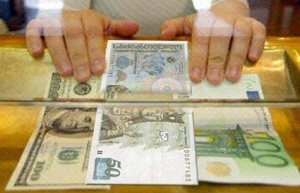Money Rolling into the Georgian Banking Sector
In just one month, the net profit of commercial banks increased by 85.3 million, in addition to increased interest income. Specialists believe that the banking sector profits directly relate to the devaluation of the Georgian Lari (GEL).
2015 January-September net profit of the banking sector amounted to 377 million GEL. Overall, bank income grew to 2,643 billion GEL. In only one month, 283-million Gel profit could be observed. According to official data from the National Bank, commercial banks had a successful quarter. Compared with the same period last year, their revenue and profits grew. Naturally, the largest share of income for banks are loans. Nine months income from loans equaled 1,452 million GEL, or 276 million more than the same period last year. Bank interest in a month equaled 190 million more GEL than usual. 97.3 million GEL income increased from loans to individuals and from legal entities, 73 million GEL. In addition, a 40 million GEL increase in income was received from commission fees.
Overall, the volume of lending by commercial banks (including loans to non-residents) reached 15.7 billion GEL. In September, 90 million in national currency in loans was issued, however, the share of loans in GEL again sharply lowered and presents only 36% (5.5 billion GEL), with 64% of loans issued in US Dollars (USD). In September this year, 238 million USD in foreign currency credit was issued. Therefore, a major challenge for the country is the loan dollarization, local and foreign experts say. Economists point out that the National Bank should have, as one of its main objectives, the reduction of the dollarization of the national currency devaluation, while, as a result of not doing so, the current social life of the population is so heavily affected. It is noteworthy that at the end of September 24.8 billion in assets of the banking sector’s own funds amounting to 3.3 billion GEL, 13.4% of total assets. Despite the fact that 19 commercial banks operate in the country, the share of the five largest banks of the banking sector assets is 79%, and two of the Banks (the Bank of Georgia and TBC) share equals 62%.
A former member of the Board, Michael Tokmazishvili, notes that the price of money changes over time. Banks and financial institutions are well aware that they do not have to disclose the amount of money for a certain amount of time after a currency depreciates. In addition, commercial banks are providing loans in GEL, but getting back in dollars.
“Banks have been getting paid in dollars according to the exchange rate issued by a loan and, accordingly, they have been able to make quite a large profit from the devaluation of the Georgian Lari,” says Michael Tokmazishvili.
Banking expert Lia Eliava, says that, compared to other sectors, the banking sector is one of the least cost effective and it is a natural process. The financial sector involves a relatively small expenditure and revenues are growing rapidly.
“Naturally, as assets and credit amounts increase, commercial bank income also increases. This process contributes to a preference for the banking sector. In addition, higher interest rates would lead to an increase in the profits of commercial banks, “ Eliava said, noting that the banking system in Georgia is quite well-built. In addition, the country is not in the risk zone that banks must lend at high percentages.
“To justify a bank by its insurance and high risk of interest rates is a little bit exaggerated. I think talking about the risk happens with the justification of existing interest rates. The National Bank can influence the commercial banks on interest rates from both administrative and economic means, but does not do so. However, commercial banks’ interest rates are an indicator of the financial sector and other participants,” says Eliava.
According to the National Bank of Georgia, the national currency loans continue to grow. The average annual interest rate of loans increased by 1.8 percentage points and annually became 20.6%. For individuals the rate is 2.1% (monthly) and 24.5% annually while USD loans have a rate of 0.1% (monthly) reached 10.9% yearly.
Dimitri Dolaberidze











